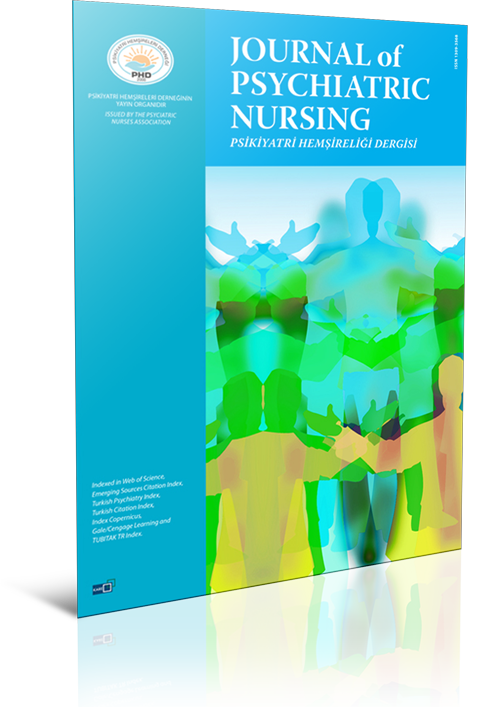
Bermond-Vorst Aleksitimi Ölçeği'nin Türkçe uyarlamasının geçerlik, güvenirliği ve Türkçe kısa formunun geliştirilmesi
Yıldız BilgeSağlık Bilimleri Üniversitesi Hamidiye Yaşam Bilimleri Fakültesi, Psikoloji Bölümü, İstanbulGİRİŞ ve AMAÇ: Aleksitimi psikopatolojinin açıklanmasında kullanılan önemli kavramlardan biridir. İki ayrı çalışmadan oluşan bu makalenin amacı, Çalışma 1de Bermond-Vorst Aleksitimi Ölçeği'nin (BVAÖ) Türkçe'ye uyarlanması, geçerlik ve güvenirliğinin incelenmesi ve Çalışma 2'de bu ölçeğin Türkçe kısa formunun geliştirilmesidir.
YÖNTEM ve GEREÇLER: Çalışma 1'de pilot uygulama için 1873 yaş aralığındaki 600 kişilik toplum örneklemi; asıl uygulama için 1766 yaş arası 766 kişilik toplum örneklemi kullanılmıştır. Çalışma 2'de 1857 yaş arasındaki 213 kişilik toplum örneklemi ve test tekrar test için 43 üniversite öğrencisi yer almaktadır. Ölçüt geçerliği için 137 üniversite öğrencisine BVAÖ ile birlikte Toronto Aleksitimi Ölçeği (TAÖ-20), Toronto Empati Ölçeği (TEÖ) ve Warwick Edinburgh Mental İyi Oluş Ölçeği (WEMİOÖ) uygulanmıştır.
BULGULAR: Çalışma 1'de iç tutarlık analizi ve açımlayıcı faktör analizi sonuçları yeterli bulunurken doğrulayıcı faktör analizi sonuçlarında uyum indekslerinin yeterli düzeyde olmadığı görülmüştür. Çalışma 2'de ise geçerlik için yapılan açımlayıcı ve doğrulayıcı faktör analizi sonuçları ve ölçüt korelasyonları ile güvenirlik için yapılan iç tutarlılık analizi ve test tekrar test korelasyonlarının yeterli düzeyde olduğu saptanmıştır.
TARTIŞMA ve SONUÇ: BVAÖ'nün 40 maddelik formunun ve ilk kez geliştirilen Türkçe kısa formunun ülkemizde kullanılabilecek geçerli ve güvenilir bir ölçek olduğunu göstermiştir. Ancak kısa formda istatistiki açıdan daha iyi sonuçlar sağlanmıştır. Ayrıca TAÖ-20 ile olan güçlü korelasyonlar BVAÖ'nün de TAÖ-20 gibi aleksitiminin değerlendirilmesinde kullanılabileceğini göstermesi açısından önemlidir.
Anahtar Kelimeler: Aleksitimi, BVAÖ; geçerlik; güvenirlik; kısa form.
Reliability and validity of adaptation to the Turkish of the Bermond-Vorst Alexithymia Questionnaire and developing of Turkish short form
Yıldız BilgeDepartment of Psychology, University of Health Sciences Faculty of Hamidiye Life Sciences, İstanbul, TurkeyINTRODUCTION: Alexithymia is one of the important concepts used in the description of psychopathology. The aim of Study 1 was to adapt the Bermond-Vorst Alexithymia Questionnaire (BVAQ) to Turkish and to examine its validity and reliability, and the aim of Study 2 to develop the Turkish short form of this scale.
METHODS: In Study 1, a community sample of 600 people between the ages of 18 and 73 for pilot application; and for the main application, a community sample of 766 people aged 1766 was used. In Study 2, there was a community sample of 213 people aged 1857, and 43 university students for test-retest. For criterion validity, 137 university students were applied Toronto Alexithymia Scale (TAS-20), Toronto Empathy Scale (TES) and Warwick Edinburgh Mental Well-Being Scale (WEMWBS) together with BVAQ.
RESULTS: In study 1, internal consistency analysis and exploratory factor analysis results were found to be sufficient, whereas the confirmatory factor analysis results the fit indexes were not sufficient. In Study 2, the exploratory and confirmatory factor analysis results and criterion correlations for validity were at a very good level. The internal consistency analysis and test-retest correlations were sufficient for reliability.
DISCUSSION AND CONCLUSION: The 40-item form of BVAQ, and developed the first time the Turkish short form is a valid and reliable scale that can be used in our country. However, it has been obtained that the short form provides statistically better results. In addition, strong correlations with TAS-20 are important in terms of demonstrating that BVAQ can be used to evaluate alexithymia, such as TAS-20.
Keywords: Alexithymia, BVAQ; reliability; short form; validity.
Makale Dili: Türkçe



















